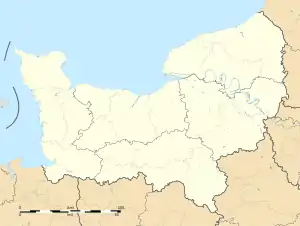Gaillefontaine | |
|---|---|
 The chateau in Gaillefontaine | |
Location of Gaillefontaine | |
 Gaillefontaine  Gaillefontaine | |
| Coordinates: 49°39′16″N 1°37′01″E / 49.6544°N 1.6169°E | |
| Country | France |
| Region | Normandy |
| Department | Seine-Maritime |
| Arrondissement | Dieppe |
| Canton | Gournay-en-Bray |
| Intercommunality | CC 4 rivières |
| Government | |
| • Mayor (2020–2026) | Jean-Pierre Henry[1] |
| Area 1 | 26.23 km2 (10.13 sq mi) |
| Population | 1,183 |
| • Density | 45/km2 (120/sq mi) |
| Time zone | UTC+01:00 (CET) |
| • Summer (DST) | UTC+02:00 (CEST) |
| INSEE/Postal code | 76295 /76870 |
| Elevation | 143–246 m (469–807 ft) (avg. 246 m or 807 ft) |
| 1 French Land Register data, which excludes lakes, ponds, glaciers > 1 km2 (0.386 sq mi or 247 acres) and river estuaries. | |
Gaillefontaine (French pronunciation: [ɡajfɔ̃tɛn]) is a commune in the Seine-Maritime department in the Normandy region in northern France.
Geography
A small town of farming, forestry and light industry situated by the banks of the river Béthune in the Pays de Bray, some 36 miles (58 km) southeast of Dieppe, at the junction of the D919, the D9 and the D135 roads.
Population
| Year | Pop. | ±% p.a. |
|---|---|---|
| 1968 | 1,452 | — |
| 1975 | 1,503 | +0.49% |
| 1982 | 1,373 | −1.28% |
| 1990 | 1,446 | +0.65% |
| 1999 | 1,460 | +0.11% |
| 2007 | 1,386 | −0.65% |
| 2012 | 1,272 | −1.70% |
| 2017 | 1,225 | −0.75% |
| Source: INSEE[3] | ||
Places of interest
- The eleventh-century church of St.Jean-Baptiste at the hamlet of Noyers.
- The eleventh-century church of St.Maurice.
- The church of Notre-Dame, dating from the thirteenth century.
- Some 17th-century remains of the abbey.
- The remains of the 11th-century castle.
- The château at Saint-Maurice
- The château de Gaillefontaine, dating from the nineteenth century.
- Several old houses, dating from the sixteenth century.
See also
References
- ↑ "Répertoire national des élus: les maires". data.gouv.fr, Plateforme ouverte des données publiques françaises (in French). 2 December 2020.
- ↑ "Populations légales 2021". The National Institute of Statistics and Economic Studies. 28 December 2023.
- ↑ Population en historique depuis 1968, INSEE
External links
Wikimedia Commons has media related to Gaillefontaine.
- Official commune website (in French)
This article is issued from Wikipedia. The text is licensed under Creative Commons - Attribution - Sharealike. Additional terms may apply for the media files.